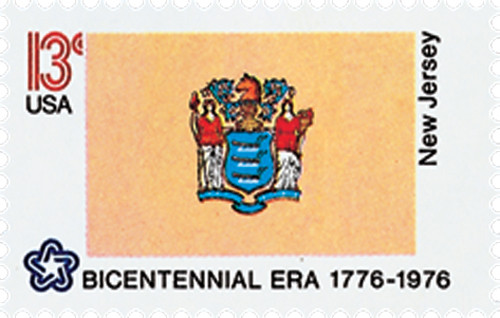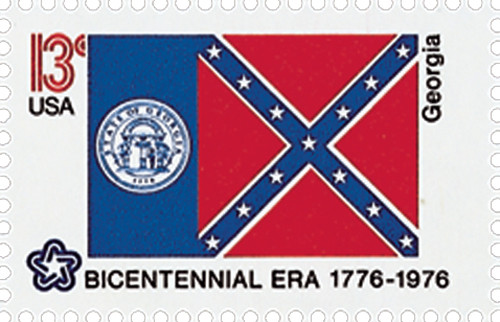
# 1649 - 1976 13c State Flags: Ohio
U.S. 1649
1976 Ohio Flag
State Flags
American Bicentennial Series
• First time a sheet 50 had all different stamp designs
• Part of the American Bicentennial Series
Stamp Category: Commemorative
Series: American Bicentennial Series
Value: 13¢ First-class postage rate
First Day of Issue: February 23, 1976
First Day City(s): Washington, DC
Quantity Issued: 8,720,100 (panes of 50)
Printed by: Bureau of Engraving and Printing
Printing Method: Photogravure
Format: Sheet of 50
Perforations: 11
Why the stamp was issued:
The United States Postal Service celebrated the American Bicentennial with a full pane of the Union’s fifty state flags.
About the stamp design:
Ohio's state flag was adopted in 1902. A large blue triangle represents Ohio's hills and valleys, while the stripes represent roads and waterways. A circle of 13 stars represents the original states of the union. Four stars added to the peak of the triangle symbolize that Ohio was the 17th state admitted to the union. The white circle with its red center represents the "O" in Ohio and refers to the state’s nickname, "The Buckeye State."
About the printing process:
Printed by the Bureau of Engraving and Printing on their seven-color Andreotti gravure press (601) which was their work horse for multicolored stamps.
About the American Bicentennial Series:
In the 1970s, America celebrated its 200th anniversary with hundreds of national events commemorating the heroes and historic events that led to our nation’s independence from Great Britain. The U.S. Postal Service issued 113 commemorative stamps over a six-year period in honor of the U.S. bicentennial, beginning with the American Revolution Bicentennial Commission Emblem stamp (U.S. #1432). As a group, the Bicentennial Series chronicles one of our nation’s most important chapters, and remembers the events and patriots who made the U.S. a world model for liberty.
Several of the stamps honored colonial life – craftsmen and communication. Other stamps honored important battles including Lexington and Concord, Bunker Hill, and Saratoga. Significant events such as the Boston Tea Party, the meeting of the First Continental Congress, and the Declaration of Independence were featured as well. The stamps also honored many significant people such as George Washington, Sybil Ludington, Salem Poor, and the Marquis de Lafayette.
Many of the stamps feature classic artwork. For instance, the set of four souvenir sheets picture important events recreated by noted artists such as John Trumbull. The Bicentennial Series also includes an important US postal first – the first 50-stamp se-tenant – featuring all 50 state flags. The format proved to be popular with collectors, and has been repeated many times since.
The American Bicentennial Series is packed with important US history – it tells the story of our nation’s fight for independence through stamps.
History the stamp represents:
Scientists believe humans may have lived in Nebraska as long as 25,000 years ago. When the first Europeans arrived in the area during the early 1700s, they found several American Indian tribes including the Missouri, Omaha, Otoe, Ponca, Pawnee, Sioux, Arapaho, and Cheyenne.
Though both France and Spain claimed the territory that included Nebraska as early as 1541, the first Europeans to set foot there didn’t arrive until nearly 200 years later. That likely occurred in 1739, when French explorers, brothers Pierre and Paul Mallet, traveled from Illinois to Santa Fe.
In 1803, the United States bought the vast Louisiana Territory, which included Nebraska, from France. President Thomas Jefferson sent an expedition led by Meriwether Lewis and William Clark to explore the Louisiana Territory in 1804. During their journey, Lewis and Clark explored the eastern portion of Nebraska. Explorer Zebulon M. Pike reached south-central Nebraska in 1806. From 1807 to 1820, the Spanish-American trader Manuel Lisa established several fur trading posts along the Missouri River. These included Fort Lisa, located about 10 miles from the site of today’s Omaha, Nebraska.
In 1819, the U.S. Army built Fort Atkinson on the Missouri River. This fort included Nebraska’s first school, library, sawmill, gristmill, and brickyard. Army Major Stephen H. Long led an expedition along the Northern Platte and Platte River valleys. Long declared the areas “unfit for farming,” calling it the “Great American Desert.”
Despite the establishment of fur trading posts, Nebraska was considered Indian land and was not available for settlement. Then, Congress passed the Kansas-Nebraska Act in 1854, creating these two territories and making them available for settlement. These territories would have been established earlier, but disagreements over slavery prevented Congress from doing so. Northerners wanted to ban slavery from new territories, while Southerners wanted to permit it. The Kansas-Nebraska Act allowed the people of the new territories to decide for themselves. The vast majority of Nebraskans were opposed to slavery.
In 1854, the Nebraska Territory included the land of the state of Nebraska and parts of Montana, North Dakota, South Dakota, Wyoming and Colorado. Then in 1862, Congress passed the first Homestead Act, which granted 160 acres of free land to western settlers. Thousands of people came to settle in Nebraska. Congress created several new territories out of this larger territory, and by 1863, Nebraska was about its current size. The Union Pacific and Burlington railroads built lines through Nebraska, and advertised its farmland to people in the East and in Europe. By 1870, Nebraska had a population of 122,993 people.
On March 1, 1867, Congress admitted Nebraska to the Union, overriding President Andrew Johnson’s veto. Republican David Butler was elected the state’s first governor. President Johnson, a democrat, had opposed Nebraska’s statehood, as he believed the republican state’s two senators would allow impeachment proceedings, which were already in progress, to convict him.
U.S. 1649
1976 Ohio Flag
State Flags
American Bicentennial Series
• First time a sheet 50 had all different stamp designs
• Part of the American Bicentennial Series
Stamp Category: Commemorative
Series: American Bicentennial Series
Value: 13¢ First-class postage rate
First Day of Issue: February 23, 1976
First Day City(s): Washington, DC
Quantity Issued: 8,720,100 (panes of 50)
Printed by: Bureau of Engraving and Printing
Printing Method: Photogravure
Format: Sheet of 50
Perforations: 11
Why the stamp was issued:
The United States Postal Service celebrated the American Bicentennial with a full pane of the Union’s fifty state flags.
About the stamp design:
Ohio's state flag was adopted in 1902. A large blue triangle represents Ohio's hills and valleys, while the stripes represent roads and waterways. A circle of 13 stars represents the original states of the union. Four stars added to the peak of the triangle symbolize that Ohio was the 17th state admitted to the union. The white circle with its red center represents the "O" in Ohio and refers to the state’s nickname, "The Buckeye State."
About the printing process:
Printed by the Bureau of Engraving and Printing on their seven-color Andreotti gravure press (601) which was their work horse for multicolored stamps.
About the American Bicentennial Series:
In the 1970s, America celebrated its 200th anniversary with hundreds of national events commemorating the heroes and historic events that led to our nation’s independence from Great Britain. The U.S. Postal Service issued 113 commemorative stamps over a six-year period in honor of the U.S. bicentennial, beginning with the American Revolution Bicentennial Commission Emblem stamp (U.S. #1432). As a group, the Bicentennial Series chronicles one of our nation’s most important chapters, and remembers the events and patriots who made the U.S. a world model for liberty.
Several of the stamps honored colonial life – craftsmen and communication. Other stamps honored important battles including Lexington and Concord, Bunker Hill, and Saratoga. Significant events such as the Boston Tea Party, the meeting of the First Continental Congress, and the Declaration of Independence were featured as well. The stamps also honored many significant people such as George Washington, Sybil Ludington, Salem Poor, and the Marquis de Lafayette.
Many of the stamps feature classic artwork. For instance, the set of four souvenir sheets picture important events recreated by noted artists such as John Trumbull. The Bicentennial Series also includes an important US postal first – the first 50-stamp se-tenant – featuring all 50 state flags. The format proved to be popular with collectors, and has been repeated many times since.
The American Bicentennial Series is packed with important US history – it tells the story of our nation’s fight for independence through stamps.
History the stamp represents:
Scientists believe humans may have lived in Nebraska as long as 25,000 years ago. When the first Europeans arrived in the area during the early 1700s, they found several American Indian tribes including the Missouri, Omaha, Otoe, Ponca, Pawnee, Sioux, Arapaho, and Cheyenne.
Though both France and Spain claimed the territory that included Nebraska as early as 1541, the first Europeans to set foot there didn’t arrive until nearly 200 years later. That likely occurred in 1739, when French explorers, brothers Pierre and Paul Mallet, traveled from Illinois to Santa Fe.
In 1803, the United States bought the vast Louisiana Territory, which included Nebraska, from France. President Thomas Jefferson sent an expedition led by Meriwether Lewis and William Clark to explore the Louisiana Territory in 1804. During their journey, Lewis and Clark explored the eastern portion of Nebraska. Explorer Zebulon M. Pike reached south-central Nebraska in 1806. From 1807 to 1820, the Spanish-American trader Manuel Lisa established several fur trading posts along the Missouri River. These included Fort Lisa, located about 10 miles from the site of today’s Omaha, Nebraska.
In 1819, the U.S. Army built Fort Atkinson on the Missouri River. This fort included Nebraska’s first school, library, sawmill, gristmill, and brickyard. Army Major Stephen H. Long led an expedition along the Northern Platte and Platte River valleys. Long declared the areas “unfit for farming,” calling it the “Great American Desert.”
Despite the establishment of fur trading posts, Nebraska was considered Indian land and was not available for settlement. Then, Congress passed the Kansas-Nebraska Act in 1854, creating these two territories and making them available for settlement. These territories would have been established earlier, but disagreements over slavery prevented Congress from doing so. Northerners wanted to ban slavery from new territories, while Southerners wanted to permit it. The Kansas-Nebraska Act allowed the people of the new territories to decide for themselves. The vast majority of Nebraskans were opposed to slavery.
In 1854, the Nebraska Territory included the land of the state of Nebraska and parts of Montana, North Dakota, South Dakota, Wyoming and Colorado. Then in 1862, Congress passed the first Homestead Act, which granted 160 acres of free land to western settlers. Thousands of people came to settle in Nebraska. Congress created several new territories out of this larger territory, and by 1863, Nebraska was about its current size. The Union Pacific and Burlington railroads built lines through Nebraska, and advertised its farmland to people in the East and in Europe. By 1870, Nebraska had a population of 122,993 people.
On March 1, 1867, Congress admitted Nebraska to the Union, overriding President Andrew Johnson’s veto. Republican David Butler was elected the state’s first governor. President Johnson, a democrat, had opposed Nebraska’s statehood, as he believed the republican state’s two senators would allow impeachment proceedings, which were already in progress, to convict him.


















